THE  OF A SOPHISTO-ROCK SAXOPHONIST BY ANNIE McCLEAN
OF A SOPHISTO-ROCK SAXOPHONIST BY ANNIE McCLEAN
Chapter 1
(The Story so Far…)

 John
Anthony Helliwell was born into a musical family in the Yorkshire town
of Todmorden on the 15 th February 1945 just 4 months after another musically
famous Todmordarian, Keith Emerson, of Emerson, Lake and Palmer fame.Exposure
to music in the Helliwell home was virtually instantaneous. Family members
were involved in every type of music from church to local Gilbert and
Sullivan productions. John’s parents duly ensured that their young
lad received the usual childhood piano and recorder lessons but none of
these musical stimuli proved very inspirational to him and it was left
to the jazz record collection of a family friend to prompt our small hero
to start his quest for a clarinet.
John
Anthony Helliwell was born into a musical family in the Yorkshire town
of Todmorden on the 15 th February 1945 just 4 months after another musically
famous Todmordarian, Keith Emerson, of Emerson, Lake and Palmer fame.Exposure
to music in the Helliwell home was virtually instantaneous. Family members
were involved in every type of music from church to local Gilbert and
Sullivan productions. John’s parents duly ensured that their young
lad received the usual childhood piano and recorder lessons but none of
these musical stimuli proved very inspirational to him and it was left
to the jazz record collection of a family friend to prompt our small hero
to start his quest for a clarinet. These were the grey fifties in post world war II England. Times were hard and some serious saving of pocket money was required to achieve his goal. Two years later and fifteen pounds poorer, he became the proud owner of a clarinet, promptly joining the Todmorden Symphony Orchestra whilst barely a teenager. His musical interests were by this time leaning increasingly towards jazz and by the age of fifteen he’d spent a further £35 on an alto saxophone and had begun playing with several school groups including the TGS5 (Todmorden Grammar School Five) which he founded. The group was quickly banned when teaching staff objected to “scandalous” lyrical content, namely the use of that dodgy word “baby”. Eminem take note!
Life in Yorkshire also involved the usual childhood
pranks and adventures with his peers. During one winter (?62/63), a particularly
cold snap caused all the local water courses to ice up. John and his best
pal decided to do a spot of messing about on the (frozen) river. The ice
gave way under our young saxophonist who duly fell in and being unable
to swim had to be dragged out by his chum. The two remain firm friends
to this day.
In common with many successful artistes, John seems to have visualized
his future path in music from a very early age. In a school essay from
his mid teens he confidently predicted a future career as a long haired
and bearded, touring jazz musician. Not bad for no crystal ball.
Chapter 2
Over the next three years a teenaged Helliwell continued to play and to study for his school leaving exams (A levels). Initially his plan was to study music at the Royal College of Music but by eighteen and the completion of his studies he had found work in Birmingham (August ’63) as a budding computer programmer for ICL, then Britain’s largest computer firm.
Music was still an important part of his life and in his free time he played in a succession of local dance and blues bands. Birmingham had a very exciting mix of musicians beginning to emerge at that time, including key future members of Traffic, ELO and the Moody Blues, all of whom crossed the young Helliwell’s path.
 John’s
first real experience of playing in a blues influenced band was the amateur
Jugs O’Henry which he joined back in May ‘65 but when Jugs
announced his intention to turn professional, John decided to chance his
luck too, moving south with the band to a London base and turning his
back on the world of computers. Gig bookings dwindled quickly and unexpectedly
so that the following year with no band and no job, our man was forced
to place an ad in the Melody Maker “Have sax, will travel.”
As luck would have it, a Swedish computer firm simultaneously offered
him a position but he plumped instead for another music job, replacing
David Green in The Alan Bown Set mark II in Feb ’66
John’s
first real experience of playing in a blues influenced band was the amateur
Jugs O’Henry which he joined back in May ‘65 but when Jugs
announced his intention to turn professional, John decided to chance his
luck too, moving south with the band to a London base and turning his
back on the world of computers. Gig bookings dwindled quickly and unexpectedly
so that the following year with no band and no job, our man was forced
to place an ad in the Melody Maker “Have sax, will travel.”
As luck would have it, a Swedish computer firm simultaneously offered
him a position but he plumped instead for another music job, replacing
David Green in The Alan Bown Set mark II in Feb ’66
Alan Bown was a trumpet player and his, for that time, daring vision of mixing horns with rock quickly began to pay off. That very same month the Bournemouth Times ran a feature on the band and a mere three months later in October John (or rather John Anthony as he was known professionally) cut his first single with the band "Emergency 999" with a December follow up of "Headline News". A first album “Outward-Alan Bown” followed in April ‘67.
By then, more high profile gigs were definitely on the cards. In August they played the Windsor Jazz and Blues festival alongside the likes of Cream, releasing another single "Toyland” in October and playing the Marquee Club in London the same month. The band’s name was truncated to “The Alan Bown” around this time. Gig attendances were on the increase along with their accompanying rock ‘n roll dangers. Just two days before Christmas, Helliwell blood was spilt when the band became involved in a huge bar fight in Dereham...
Chapter 3
In July ‘68, the band performed on one of the hippest UK tv music shows of the time, the "Simon Dee Show" and also made it to London’s Royal Albert Hall for a show which included Joe Cocker and the Bonzo Dog Doo-Dah Band. The latter was a highly eccentric and comic combo featuring the late Viv Stanshall, a bespectacled, blond haired and bearded brass player with more than a passing resemblance to John, as would be subsequently commented on by the media in the 70s. As an aside, the BDDB eventually recorded “Little Sir Echo” which John would occasionally choose to perform in his future solo “guest spots” with Supertramp.
A second album “Second album” was released and John continued on with The Alan Bown over the next four years, successively recording “We Can Help You ’; “Outward Bown"; "Gypsy Girl"; "The Alan Bown - Listen" and "The Alan Bown Stretching Out" .
The latter, a 1971 album, contained the only Helliwell composition to date, "Turning Point". A number of personnel changes occurred in the latter years, not least in ’69 with the addition of the late Robert Palmer as new vocalist. Dougie Thomson came on board on bass for what was to be the last six months of the band’s life.
In March 1972 The Alan Bown disbanded leaving the 27 year old Helliwell in search once more of a new musical vehicle. Dougie and he had by now formed a firm friendship and the two attempted to start up a new band “Wizard” (not to be confused with Roy Wood’s band). Their venture was short lived and both (now married) men had to resort to taking whatever music jobs they could. John was in the nightmarish position of also having to deal with an overdue tax bill, the result of a mix-up whilst playing with The Alan Bown. He found a day job working in a dry cleaners but also had to work evenings playing the clubs, pubs and even seedy strip joints of London till the wee hours of the morning, grabbing sleep whenever he could till the tax bill was paid off.
Around this time Dougie joined forces with a struggling Supertramp and meanwhile John, taxes paid, did a spot of UK touring, then took off for Germany, reluctantly leaving his wife Christine back in England. The work involved playing around various American Air Force Bases but after only a few months (Aug. ’73) John was glad to return to his family back in Blighty. Rumour has it that the gifted “20 stone multi-instrumentalist”, Pete Lancaster whom he was gigging with at the time, is still performing in Germany to this day.
Chapter 4
Just a few weeks after John’s return, Dougie got back in touch and invited him down informally for a bit of a session with Supertramp. They’d all become aware of his considerable musical prowess due to the fact that both Supertramp and The Alan Bown had occasionally played together on the same bill but his permanent inclusion in the band seems to have been clinched by his equal talents in the joke telling department, a skill which he would later use to good effect on stage in his role as Supertramp’s master of ceremonies.
He is rumoured to have broken the ice with his future band mates by telling one of his many jokes. "Did you hear the one about the Irishman who received water skis for Christmas?” [Answer: He spent the whole holiday looking for a lake with a slope]. And thus, at Dougie’s invitation, John sat in with the band and was instantly impressed. That first day they worked on a number of songs which would eventually see the light of day as Crime of the Century tracks.
 One
of the first songs that John recalls hearing was “From Now On.”
John continued to return to successive ‘tramp rehearsals until he
eventually began performing gigs with them. No one, least not our sax
player, can remember exactly when this was or can even remember him being
asked to join formally! Supertramp were also in a pretty bad way both
in terms of finance and band morale. John like the other members, realized
that some day-work was necessary to keep body and soul together whilst
the band were in rehearsal time and so worked as a petrol pump attendant
and even took mind numbing work screwing nuts and bolts together on pipes
before resorting to going out on tour for a stint with the soul singer
Jimmy Ruffin.
One
of the first songs that John recalls hearing was “From Now On.”
John continued to return to successive ‘tramp rehearsals until he
eventually began performing gigs with them. No one, least not our sax
player, can remember exactly when this was or can even remember him being
asked to join formally! Supertramp were also in a pretty bad way both
in terms of finance and band morale. John like the other members, realized
that some day-work was necessary to keep body and soul together whilst
the band were in rehearsal time and so worked as a petrol pump attendant
and even took mind numbing work screwing nuts and bolts together on pipes
before resorting to going out on tour for a stint with the soul singer
Jimmy Ruffin.
Finally, with enough Supertramp demo tracks recorded, A&M gave the go ahead for a third album to be recorded and in Nov. ‘73 John and Christine moved out of London to join the rest of the band and their families for a spot of communal living in an isolated Somerset cottage “Southcombe Farm”.
Three months later Crime of the Century was ready to be recorded and the Helliwells relocated back to Maidenhead outside London. John started recording tracks at Trident studios in Jan ‘74 including a single “Land Ho/ Summer Romance” which was subsequently remixed and released in February just after John turned 29.
The first Helliwell official public appearance with Supertramp was in March ’74 at the Queens Club in Westcliff although he had also performed the new single with them on the BBCs “Rock On” some weeks previously. Recording for Crime of the Century was finished by June and released in September.
Prior to Dreamer being released in December ’74 as the new single, Supertramp had actually performed it several times that autumn on BBC tv. John is memorable in these clips for “playing” water-filled wine glasses by rubbing the rims.
This was supposed to be providing some of the sustained synth sounds but was merely an eye catching stage device. John headed off in October with Supertramp mk. III on their first tour of Great Britain which ended just before Christmas ‘74, at which point COTC was at number 4 in the UK charts and the nation’s music press were clamoring to run pieces on the band and the album.
Chapter 5
John no doubt grabbed a few precious weeks of down time with Christine over the holiday period but the new year (end of Jan ’75) saw him out on the road in the UK with Supertramp once more, playing to around a dozen venues. They came off the road just days before John turned 30, then headed over to France for a one off February show at the “Bataclan”, the show immortalized in the sleeve notes of “Paris”.
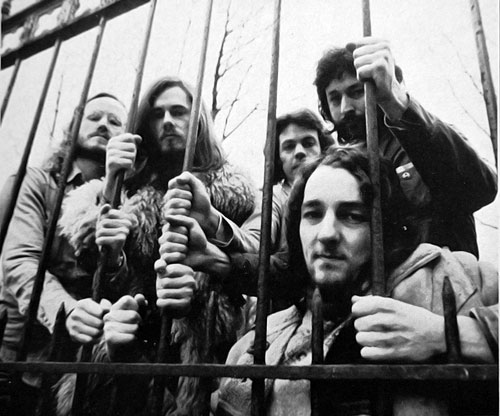 If
stories are to be believed the promoter had had little success in selling
the tickets prior to their arrival. On the day of the performance with
a mere handful shifted, the band recalls taking to the street and attempting
to give tickets away to passers by. The show lives on as a French radio
recording and probably afforded John his first opportunity to try out
his linguistic skills on stage by talking to the crowd partially in French.
If
stories are to be believed the promoter had had little success in selling
the tickets prior to their arrival. On the day of the performance with
a mere handful shifted, the band recalls taking to the street and attempting
to give tickets away to passers by. The show lives on as a French radio
recording and probably afforded John his first opportunity to try out
his linguistic skills on stage by talking to the crowd partially in French.
 A
much more fluent but equally self assured John took to the stage of London’s
Hammersmith Odeon the next month on March 9 th. The gig was a last minute
add-on to the end of the tour and has become famous or rather perhaps
infamous as an illegal bootleg beloved amongst Supertramp fans. It was
also briefly commercially released in 2001 as “Is Everybody Listening”.
For some bizarre reason the original bootleg erroneously gave the venue
for this show as Cleveland, Ohio rather than London, England, a mistake
which the 2001 commercial release unfortunately replicated on its own
cover notes.
A
much more fluent but equally self assured John took to the stage of London’s
Hammersmith Odeon the next month on March 9 th. The gig was a last minute
add-on to the end of the tour and has become famous or rather perhaps
infamous as an illegal bootleg beloved amongst Supertramp fans. It was
also briefly commercially released in 2001 as “Is Everybody Listening”.
For some bizarre reason the original bootleg erroneously gave the venue
for this show as Cleveland, Ohio rather than London, England, a mistake
which the 2001 commercial release unfortunately replicated on its own
cover notes.
Be that as it may, the recording presents a highly dynamic live band, tearing through many of the current Crime of the Century AND future Crisis? What Crisis? numbers.
Moreover, it’s heartwarming evidence of a zany,
and firmly tongue in cheek Helliwell MC, whose pithy wit has delighted
Supertramp audiences the world over. He can be heard welcoming the Hammersmith
audience thus:
“Thanks man.... Good evening. Welcome to my show and I'd
like to do another one now. This is from my album. I shall be supported
by Rick and Roger on vocals on this one. This is called .... Ooh another
thing. We've got a little guest vocal group tonight. These are "The
Trampettes" and they'll be appearing at the end of this number. They're
pretty cool so don't applaud too much. This is "Hide in Your Shell"...
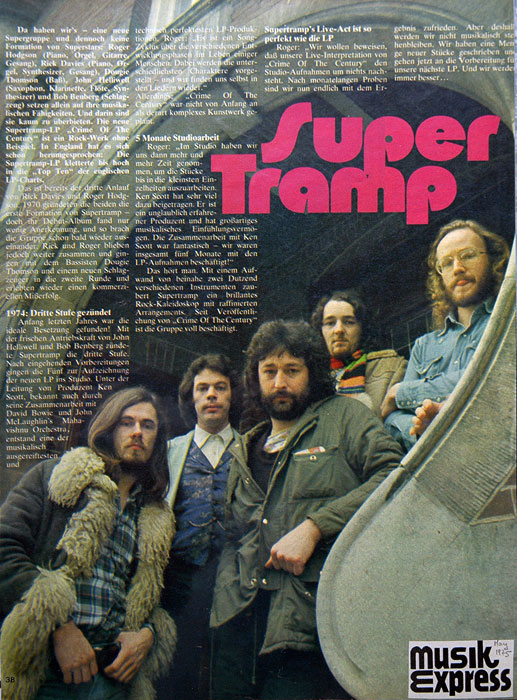 Later
on, when a lone heckler in the crowd continued to push his luck too far,
our man confidently halted proceedings to have a word with him thus:
Later
on, when a lone heckler in the crowd continued to push his luck too far,
our man confidently halted proceedings to have a word with him thus:
Ooh we've got the chap from "rent-a-mouth” here tonight [crowd and Dougie laugh and cheer] Yeah... anyway to continue... Hey listen. To get on 'ere you need some material and the only material you've got is that shitty suit you're wearing [huge crowd applause].
John ‘fessed up to this put down of put downs being borrowed from the old bass player in The Alan Bown. Whatever, it swiftly did the job and elicited a huge cheer from the giggling crowd. The heckler was heard no more.
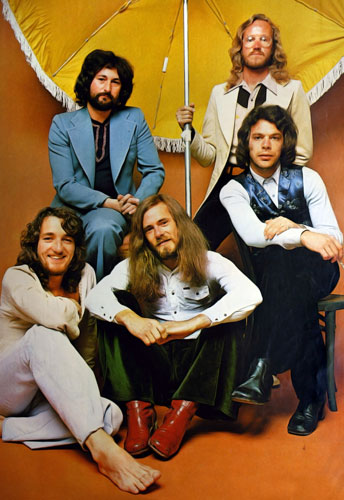 The
same recording has further evidence of his great wit and also perhaps
personal disregard for safety. During this tour, he’d had a specially
wired up jacket made, encrusted with fairy lights to give that special
“glow in the dark” effect. He can be heard instructing Irish
roadie Norman Hall to “Turn me on man” at which point Norman
dutifully plugged him into the mains electricity! Twinkling in the darkness,
he accompanied himself on the piano and generally hammed it up whilst
singing “The Alphabet Song” (A You’re Adorable) but
on other nights would occasionally swap this for “Little Sir Echo”
a song he’d had taught to him by his uncle in his childhood days.
The
same recording has further evidence of his great wit and also perhaps
personal disregard for safety. During this tour, he’d had a specially
wired up jacket made, encrusted with fairy lights to give that special
“glow in the dark” effect. He can be heard instructing Irish
roadie Norman Hall to “Turn me on man” at which point Norman
dutifully plugged him into the mains electricity! Twinkling in the darkness,
he accompanied himself on the piano and generally hammed it up whilst
singing “The Alphabet Song” (A You’re Adorable) but
on other nights would occasionally swap this for “Little Sir Echo”
a song he’d had taught to him by his uncle in his childhood days.
Chapter 6
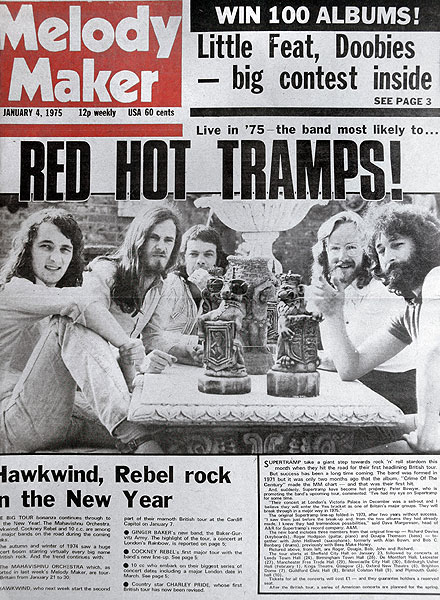 Supertramp
now had their sights set on more distant lands and in less than a month
(April ‘75) John found himself playing in Supertramp’s first
ever American show in Milwaukee. Christine stayed behind in England and
the same month gave birth to the couple’s first child, Charles Louis
on the night that Supertramp performed in St. Louis Missouri. After playing
further US and Canadian dates, the band members found themselves on the
west coast and were able to put down some kind of roots, renting accommodation
in the Venice Beach area outside of LA. At that time it wasn’t perhaps
what the Helliwells had been used to in Maidenhead – John recalled
one sticky moment where he exited his apartment and walked straight into
a posse of policemen, guns drawn in hot pursuit of a felon. Shaken, he
quickly followed their “Son get back inside” instructions.
Supertramp
now had their sights set on more distant lands and in less than a month
(April ‘75) John found himself playing in Supertramp’s first
ever American show in Milwaukee. Christine stayed behind in England and
the same month gave birth to the couple’s first child, Charles Louis
on the night that Supertramp performed in St. Louis Missouri. After playing
further US and Canadian dates, the band members found themselves on the
west coast and were able to put down some kind of roots, renting accommodation
in the Venice Beach area outside of LA. At that time it wasn’t perhaps
what the Helliwells had been used to in Maidenhead – John recalled
one sticky moment where he exited his apartment and walked straight into
a posse of policemen, guns drawn in hot pursuit of a felon. Shaken, he
quickly followed their “Son get back inside” instructions.
 John
and Supertramp returned briefly to the recording studio in LA in the summer
of ’75, to begin work on his second album with the band. He headed
off to play several more N. American dates with them before returning
home to London and the autumn completion of work
on what would become “Crisis? What Crisis?
John
and Supertramp returned briefly to the recording studio in LA in the summer
of ’75, to begin work on his second album with the band. He headed
off to play several more N. American dates with them before returning
home to London and the autumn completion of work
on what would become “Crisis? What Crisis?
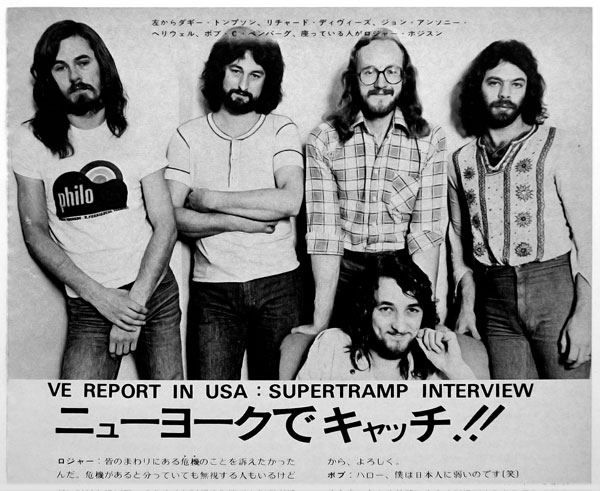 With
the single release of “Lady” from the album, Supertramp returned
to the road in November of ’75 for a UK tour to coincide with the
album’s release. After a brief respite for Christmas, it was off
once more in January, this time on a European tour. The tour ended triumphantly
with a sold out Royal Albert Hall show, at which John announced the birth
of Jesse Siebenberg to the assembled 6000 crowd. Little did he know that
the same lad would be playing percussion on that very stage with them
twenty two years later in 1997.
With
the single release of “Lady” from the album, Supertramp returned
to the road in November of ’75 for a UK tour to coincide with the
album’s release. After a brief respite for Christmas, it was off
once more in January, this time on a European tour. The tour ended triumphantly
with a sold out Royal Albert Hall show, at which John announced the birth
of Jesse Siebenberg to the assembled 6000 crowd. Little did he know that
the same lad would be playing percussion on that very stage with them
twenty two years later in 1997.
The band had by this time decided to make a go of it
in the States, intending to relocate permanently to the west coast. John
and Christine sold off their house contents and the band embarked on a
global tour for the new album. John spent the next few months touring
N. America and in May headed with the band towards Japan then Australia
and New Zealand.
Chapter 7
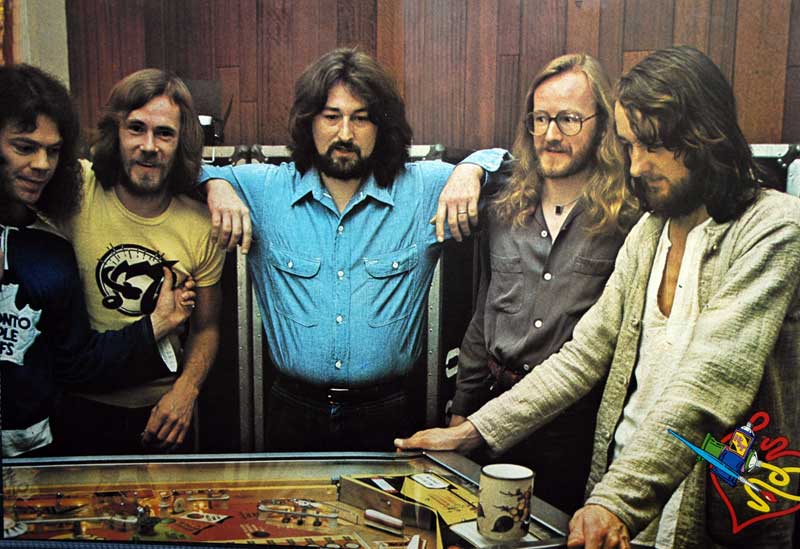 After
a summer free from performing, it was once again time for John to start
work on his third Supertramp album with rehearsals starting in early autumn
’76. Recording followed at Colorado’s Caribou Studios and
was completed in the week prior to Christmas ’76. Holiday festivities
out of the way, the band began mixing at the Record Plant. Friends of
the band were invited to provide the background vocals on “From
Now On” but the normally mild mannered perfectionist lost the plot
a little when the assembled group persistently sang out of tune. In exasperation
he’s alleged to have yelled “Why can’t these bastards
sing in tune?”
After
a summer free from performing, it was once again time for John to start
work on his third Supertramp album with rehearsals starting in early autumn
’76. Recording followed at Colorado’s Caribou Studios and
was completed in the week prior to Christmas ’76. Holiday festivities
out of the way, the band began mixing at the Record Plant. Friends of
the band were invited to provide the background vocals on “From
Now On” but the normally mild mannered perfectionist lost the plot
a little when the assembled group persistently sang out of tune. In exasperation
he’s alleged to have yelled “Why can’t these bastards
sing in tune?”
Examination of any publicity shots from around this time
onwards shows John to be wearing a simple small, dark, rectangular pendant.
An American fan rather mysteriously sought him out at a stage door after
one mid seventies performance, presented 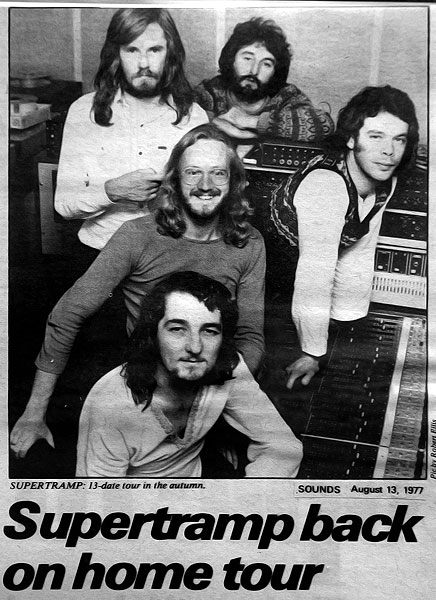 him
with the piece and made some statement about it being able to bring luck
to the band ie “wear it always and you will continue to perform
together” – something like that. It’s a nice touch that
no matter where he is in the world, to this day, whether playing with
Supertramp or Roger Hodgson, that he will always have the pendant around
his neck.
him
with the piece and made some statement about it being able to bring luck
to the band ie “wear it always and you will continue to perform
together” – something like that. It’s a nice touch that
no matter where he is in the world, to this day, whether playing with
Supertramp or Roger Hodgson, that he will always have the pendant around
his neck.
Our man celebrated his 32 nd birthday just weeks before the release of “Even in the Quietest Moments” and the start of its accompanying global tour in Canada. As the band worked their way across N. America John was asked by producer Toni Visconti to take time out in Toronto to record two tracks with Bob Siebenberg’s brother-in-law, Scott Gorham and his band Thin Lizzy which included the hit single “Dancin’ in the Moonlight”.
John completed performances with Supertramp in the US then caught up with Thin Lizzy back in London in late August ’77 to make a live appearance with them on the BBV TV show, “Top of the Pops”. A few days later he and Supertramp were off to Denmark to commence a European tour which brought them to the UK mid October. Using a camera he picked up on an earlier tour, John commenced a photographic study which consisted of the daily “view from my window” of whichever hotel and city he was in. To date the project remains unpublished but it would make a fascinating study of life on the road as seen from the eyes of a traveling musician.
The band reached London on the 10 th November to wind up the tour, filming some of their best known live band footage at St. Mary’s College that evening. It’s perhaps no coincidence to note that this and the earlier recorded Hammersmith shows are both “end of tour” shows.
Chapter 8
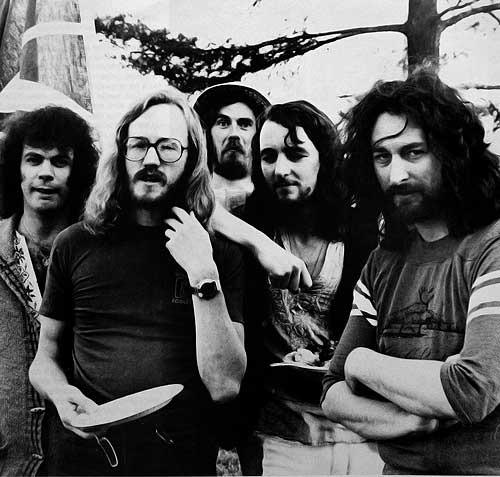 By
March ‘78 the boys were back hard at work on the next album
By
March ‘78 the boys were back hard at work on the next album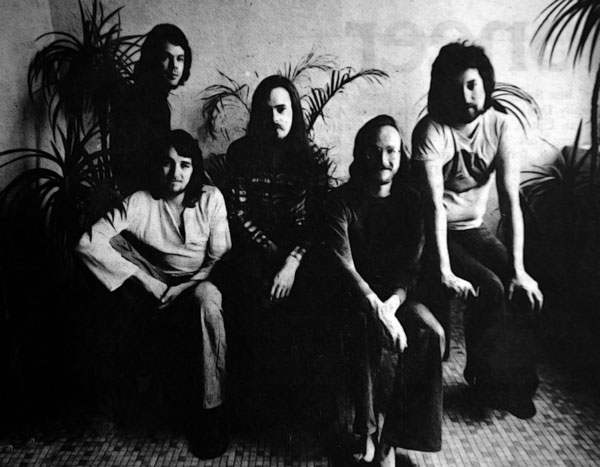 in Rick’s Californian home. The following month they took a rehearsal
space at LA’s Burbank studio, naming it for the English cottage
where they had first put COTC together some five and a half years previously.
Relocation to LA’s Village Recorders followed only a matter of weeks
later and recording commenced on “Breakfast in America” in
Studio B (Studio A was for at least part of the time occupied by Steely
Dan working on their last album of the 20 th Century, “Gaucho”).
in Rick’s Californian home. The following month they took a rehearsal
space at LA’s Burbank studio, naming it for the English cottage
where they had first put COTC together some five and a half years previously.
Relocation to LA’s Village Recorders followed only a matter of weeks
later and recording commenced on “Breakfast in America” in
Studio B (Studio A was for at least part of the time occupied by Steely
Dan working on their last album of the 20 th Century, “Gaucho”).
Studio B only had one recording booth and as the backing for tracks such as The Logical song were recorded live, John was dispatched to the toilet to play his solos. Engineer Pete Henderson bemusedly recalled, “He used to complain about it a lot, but I think he was actually quite happy being in there."
He was allowed out to contribute backing vocals to some of the tracks and is even the “heavy breather” heard exhaling at the start of every bar in the introduction to “The Logical Song”.
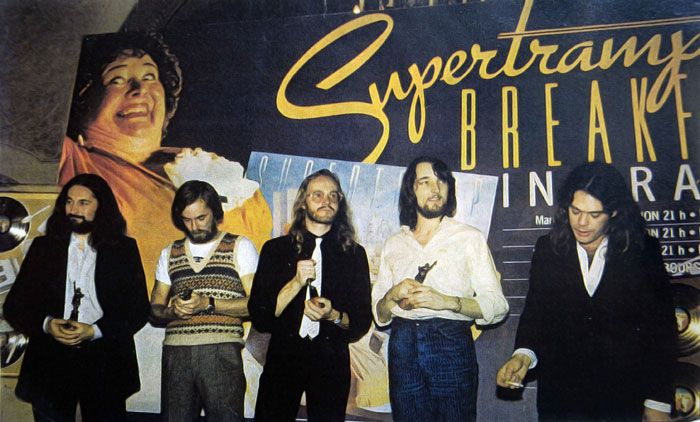
Recording for Breakfast in America finished at the end of ’78. The album cover design was completed by including a photo of the band on the back. For the location they chose Bert’s Mad House on La Brea Avenue in LA, located literally just across the street from the studios (sadly it’s now gone, rumoured to have been turned into a parking lot). Look carefully and all the musicians are reading a newspaper from their own home towns. John’s Manchester Evening News represents his nearest city to Todmorden.
With the album’s release in March ’79 it was time for John to take to the road again. The North American tour leg got underway in St. Louis and worked its way across N. America until mid August. Supertramp were on the crest of a wave. In Buffalo in May the Mayor even presented them with the keys of the city which John gleefully accepted on stage.
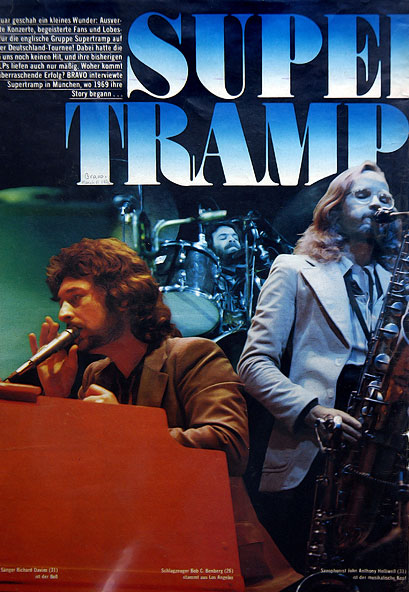 European
touring brought them to Paris on the 29 th November ‘79 for the
legendary recording and filming of the show which would be issued as the
double live album “Paris”. Surviving footage showed John as
ever really getting into the swing of things. In black wrap around sunglasses
and with his trade mark flowing blond locks, he ducked and dived his way
around the stage, at one point climbing on to the grand piano and lying
on his back, microphone in hand, to sing the backing vocals for “Dreamer”.
His voice is heard greeting the audience in French and his introductory
detailed descriptions of the various recent meals he’d had, have
become as much a part of the live recording as has the music. His ability
to learn a few sentences of the language of whatever country he is performing
in is a trait which continues to endear him to continental fans.
European
touring brought them to Paris on the 29 th November ‘79 for the
legendary recording and filming of the show which would be issued as the
double live album “Paris”. Surviving footage showed John as
ever really getting into the swing of things. In black wrap around sunglasses
and with his trade mark flowing blond locks, he ducked and dived his way
around the stage, at one point climbing on to the grand piano and lying
on his back, microphone in hand, to sing the backing vocals for “Dreamer”.
His voice is heard greeting the audience in French and his introductory
detailed descriptions of the various recent meals he’d had, have
become as much a part of the live recording as has the music. His ability
to learn a few sentences of the language of whatever country he is performing
in is a trait which continues to endear him to continental fans.
Chapter 9
 “Paris”
the double live album released in ’80, is also evidence of the musical
quoting which John delights in. Take a listen to the album’s version
of “Bloody Well Right” and you’ll find him skillfully
inserting the opening bars of Duke Ellington's "Rockin' In Rhythm".
He doesn't appear to have used the riff prior to this tour but it can
be heard even more completely on Live '88. Whatever town he plays in on
tour, he also likes to research its well known melodies then attempt to
weave them into some of the show numbers that night.
“Paris”
the double live album released in ’80, is also evidence of the musical
quoting which John delights in. Take a listen to the album’s version
of “Bloody Well Right” and you’ll find him skillfully
inserting the opening bars of Duke Ellington's "Rockin' In Rhythm".
He doesn't appear to have used the riff prior to this tour but it can
be heard even more completely on Live '88. Whatever town he plays in on
tour, he also likes to research its well known melodies then attempt to
weave them into some of the show numbers that night.
RTL radio in Paris invited John and Roger Hodgson into their studios during one of the days of their autumn shows in ’79. John brought along his clarinet and the pair performed a breathtaking version of Even in the Quietest Moments but the biggest surprise of the entire session was when he suddenly took over the keyboards and played Joni Mitchell’s “Morning Morgantown”! Evidently his childhood piano lessons hadn’t been in vain.
With the touring ended soon after this, John had most of ’80 off and was able to spend time with his family back in LA. He was able to indulge in his pastimes, one of which was bicycling. He liked nothing better than to cycle up and down the steep hills around his canyon home but one day in January ’81 he simply rounded a corner too sharply, fell off and suffered a bad break to his leg, requiring surgery to fit a metal plate and pins which he has to this day. Once over this set back, it was time to regroup with his fellow musicians and think about their follow-up to “Paris”.
 Work
for the album “…famous last words…” took most
of ’82. Just before its release in October, John guested on David
Letterman’s “The Late Show” and was then dispatched
in November on a solo round-the-world publicity jaunt for the album’s
forthcoming singles. Over in London, BBC Radio 1’s “Newsbeat”
caught up with him and asked him if he’d ever done the standard
rock ‘n roll thing of wrecking his hotel room. Our man assured them
that that had never happened but as an after thought added “but
we did once throw a dead fish on to the roof of an ambassador’s
car!”
Work
for the album “…famous last words…” took most
of ’82. Just before its release in October, John guested on David
Letterman’s “The Late Show” and was then dispatched
in November on a solo round-the-world publicity jaunt for the album’s
forthcoming singles. Over in London, BBC Radio 1’s “Newsbeat”
caught up with him and asked him if he’d ever done the standard
rock ‘n roll thing of wrecking his hotel room. Our man assured them
that that had never happened but as an after thought added “but
we did once throw a dead fish on to the roof of an ambassador’s
car!”  Prior
to his departure from the States, John took part in the video recording
for both singles from the album. The second, “My Kind of Lady”
had a 50s feel to it and required John and the others to shave off their
trademark beards. He also found time to film intros for a music documentary
“Les Enfants du Rock” for European tv w hich portrayed him
tongue in cheek as a TV studio anchorman.
Prior
to his departure from the States, John took part in the video recording
for both singles from the album. The second, “My Kind of Lady”
had a 50s feel to it and required John and the others to shave off their
trademark beards. He also found time to film intros for a music documentary
“Les Enfants du Rock” for European tv w hich portrayed him
tongue in cheek as a TV studio anchorman.
John packed his bags for yet another tour, playing the first of many ’tramp shows in Sweden at the start of June ’83.
On 24 th June he played in front of some 80 to 85 thousand souls at the Parc de Seaux in Paris which at that time was the largest ever audience assembled at a concert.
Just five days later the tour reached London’s Earl’s Court (29 th June). One piece from the British press at that time describes John as “tall, bearded and quite definitely the skinniest 38-year-old in rock 'n' roll. He's also the possessor of an enviable tan.”
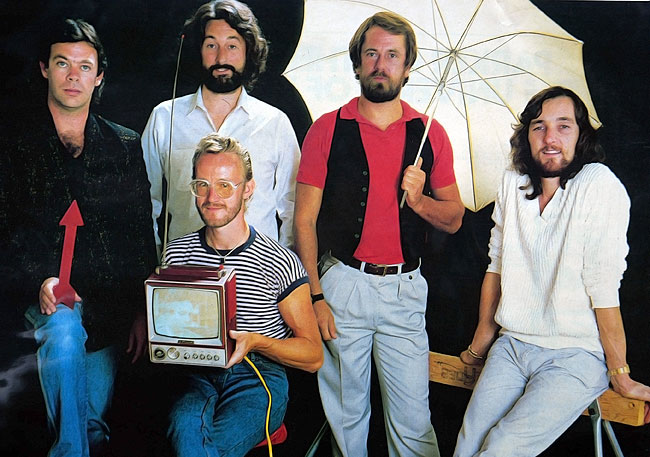 The
band got to the capital city just in time for the mens’ tennis finals
at Wimbledon, an event which John and several of the others managed to
get tickets to. John McEnroe, at that time one of the world’s top
tennis stars, was obviously also a Supertramp fan and turned up in the
front row at one of the London shows. John delighted in pointing him out
to the crowd and “serving” an imaginary tennis ball at him
from the stage.
The
band got to the capital city just in time for the mens’ tennis finals
at Wimbledon, an event which John and several of the others managed to
get tickets to. John McEnroe, at that time one of the world’s top
tennis stars, was obviously also a Supertramp fan and turned up in the
front row at one of the London shows. John delighted in pointing him out
to the crowd and “serving” an imaginary tennis ball at him
from the stage.
In August the N. American part of the tour started, ending
on the 25 th September ’83 at Irvine Meadows in California. This
was to be Roger Hodgson’s last show with the band – it was
John who presented him on stage with an inscribed gold watch. An emotional
evening for all concerned.
Chapter 10
New phase of John’s life with Supertramp began after Roger’s departure. From now on Rick Davies would be the sole writer. By mid ’84 he and the remaining band members had assembled once more to begin work on John’s seventh album with them, “Brother Where You Bound”. The cover work features coloured ape to humanoid outlines on a white background. It became the “in” joke within the band to identify which level of evolution matched what musician. John claims that he is of course on the right hand side as the fully evolved human.
In May ’85 the band and a huge gaggle of reporters met up in Paris and took the luxurious “Orient Express” to Vienna with the purpose of attending the premiere of the very ambitious film for “Brother” filmed by Rene Daalder. By all accounts the wine flowed and a good time was had by all – and so they should have, with tickets costing a “mere” $600 a head. John and Rick commandeered the piano in the lounge and played into the wee small hours much to the alarm of all the terribly posh, staid older couples on board.
Yet another Helliwell out-on-the-road period ensued in late September ’85 starting way out west in St. John Newfoundland as ‘tramp began its touring of N. America. By February the band were over in Europe. Just three days after John’s 41 st birthday he became a father for the second time. His second son William was born back home in Santa Monica whilst John was in the midst of touring. However by March ’86 he’d again reached London, and could this time be joined by his family. The band performed at the Royal Albert Hall in aid of the Prince’s Trust in front of Prince Charles and Princess Diana. The elder Helliwell son, Charles was asked to sit with them in the Royal Box. Diana had always professed to being a big ‘tramp fan and Charles Helliwell got to introduce both royals to the band backstage prior to the show.
In ’87 John and Supertramp recorded “Free As A Bird”, a more experimental album that toyed with modern technology. He freely states that this wasn’t perhaps their best idea but then again, hind sight is a wonderful thing. With the album’s release in autumn of that year, John had Christmas with his family and then flew south in the new year to Rio de Janeiro for the start of the “World Migration Tour” which eventually finished off (May ’88) in London at the Royal Albert Hall.
The end of the 80’s marked the start of a dormant period for the band
Chapter 11
Musically with the apparent laying off of Supertramp, John began to consider studying for a music degree. He knew he’d want to study at the Royal Northern College of Music in Manchester and this may have been one of the family’s decisions in relocating back to Yorkshire some time in the early 90’s. However he kept in contact with all his Supertramp buddies including Roger Hodgson and when asked by Roger to go out on the road in America for a mini series of gigs, accepted readily. The “Rites of Passage” band played several Californian dates in the summer of ’96. The last date (2 nd August in Nevada City) was recorded live and issued as the CD “Rites of Passage”.
The new Supertramp album “Some Things Never Change” took shape over 1996. However there was a very big snag looming on the horizon. John was by now living back in England and was well into his degree course in Manchester. If all went to plan it should occupy him for the following year, a year which Rick had earmarked for a new Supertramp tour. After much soul searching, the oldest student on his course, the 51 years young John decided to shelve his degree for the time being and get back out on the road.
The “It’s About Time” tour was announced towards the end of 1996, marking the emergence of Supertramp mark IV. John and the others began their tour in Europe in April, reaching N. America by mid July.
On 9 th April 1997, John, Rick and Bob were awarded with the “Chevalier de l’ordre des Arts et Lettres” medal by the French Government. This green and white medal is one of the country’s most distinguished cultural awards and is a measure of just how highly the French regard Supertramp (as an example, Bowie wasn’t awarded his until late ’99!)
The tour crossed back again to Europe in September ‘97, proceeding to sell out a further five consecutive nights at The Royal Albert Hall. John took on his usual role of MC and revelled in his intro to “Take the Long Way Home” which consisted of a mock safety announcement advising the audience about traffic jams or diversions all around the venue. Of course half way through it, a giant Helliwell “talking head” appeared, looking down at the stage from the video screen. In a classic moment John got to talk to his alter ego, the virtual image peering down at him and saying “John. Listen – all you’ve got to say to them is, ladies and gentlemen when you go home tonight, take the long.. way.. home”. The ever sartorial MC definitely surpassed himself on this tour, appearing most nights in a silver John Paul Gautier suit (apparently he had a second one in a brown tone which he wore to some shows).
At the end of the tour John retired back to Yorkshire to home and family. His tour performance was again preserved for posterity the following year with the release of the live double album “It Was The Best of Times” which had been recorded back in London the previous 19th and 20th September.
Chapter 12
Towards the end of 1999 he took time out to travel into Manchester to meet up with Tim “TJ” Tjernlund, an American Supertramp historian and compiler of a band “time line” from whence many of the dates quoted in this bio were obtained. Tim and John spent an afternoon trying to put some sort of chronology on to all the facts and figures collected by TJ over the years.
In 2001, Rick Davies regrouped John and the others to record their first album of the new millennium, “Slow Motion”. This time John and his colleagues were presented with pretty much the finished article. Rick in an almost “solo album” venture had conceived the album on his own and now handed each musician detailed demos for each to work from. Most of it hit the spot but in a radio interval John had a little chuckle over a mysteriously ditched track called “Flight 29”. This, quite apart from having an unfortunate title given the tragedy of September 11 th, got a rather lukewarm response from the various musicians when they heard it. When Rick told an interviewer “I don’t think they liked it very much” John quipped back with, “It was just when were stamping up and down on the [demo] CD that he realized.”
Slow Motion hit the shops early in 2002. John flew to Paris to reunite with the others in rehearsals for several weeks before they commenced touring in Spain the next month. It was in Barcelona’s Olympic Stadium on the 28 th April that John announced proudly in Spanish to the assembled 15000 throng that he’d just become a grandfather ("Hoy he sido abuelo"). His first grandchild, Edgar Helliwell, was born in New Zealand. Obviously delighted, he mugged around on stage pretending to wobble about on a walking stick. Mark Hart joined in his celebrations by substituting “Grandpa John Helliwell” at the point where he would normally sing “Mr. John Helliwell” during The Logical Song. Poor Rick Davies was so overwhelmed that when introducing the band he referred to John as "a grandma... no wait.. grandad...grandad...”
Chapter 13
John has undoubtedly influenced many younger aspiring musicians to turn professional. One such person is French saxophonist Laurent Hunziker. On the 7 th May, John invited Laurent and his sax quartet on stage at the Paris Bercy show to guest with him on “Over You”, playing a special arrangement John had written out just for that show. It’s probably the first time apart from “trampette singers” that “outside” musicians have joined Supertramp on stage for such a one-off appearance. There is one other known exception to this however! Music is definitely in the Helliwell genes. John’s younger son William has become an accomplished trumpet player. On the 17 th July ‘02 in Edinburgh, the teenaged William appeared on stage to play “Goodbye Stranger” with his father and Supertramp. At the end of the number, apparently even tough old roadies had a tear in their eye whilst his proud father could be seen mouthing to the audience, “that’s my boy!”
More recently in January 2004 John was reunited with Alan Simon, members of the Gaïa Band, Jesse Siebenberg and Roger Hodgson at “Art on Ice” - an ice and music spectacular staged in Zurich. They performed three Supertramp numbers, John commenting that, when it came to playing “It’s Raining Again” this was the first time he’d performed it on stage with Roger in some 21 years. Scary stuff.
In March 2004 John, some friends and his son William performed a jazz concert in their home county of Yorkshire. If rumours are to be believed, there are many more jazz performances to come. John, created his own Jazz group, with most talented musicians : It is called " Crème anglaise "... Beside this, John also plays in the ensemble "Sax assault"...
To be continued……
Postscript: The above has concentrated on John’s recording career within Supertramp. He has also played sax on recordings for many other world class acts not least Diana Ross and Chris de Burgh.
There may be more to come from Supertramp, but right now I’m playing music based on my many inspirations, including jazz, funk, blues, soul and rock, with some of my favourite musicians. We are called John Helliwell’s “Crème Anglaise” and the band variously includes: Mark Hart (vocals, guitar and keyboards) from ‘Supertramp’ and ‘Crowded House’, Mike Walker (internationally acclaimed jazz guitarist), multi-talented organist and vocalist John Ellis, the rocking Geth Griffith on double bass and bass guitar, pianistic star Arthur Lea, and stellar drummer Ben Bryant.
Have a listen to our CD “Crème Anglaise” - if you like it half as much as we do, then we like it twice as much as you do! Come and see and hear us in a place near you!

